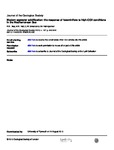Modern seawater acidification: the response of foraminifera to high-CO <sub>2</sub> conditions in the Mediterranean Sea
| dc.contributor.author | Dias, BB | |
| dc.contributor.author | Hart, Malcolm | |
| dc.contributor.author | Smart, Christopher | |
| dc.contributor.author | Hall-Spencer, Jason | |
| dc.date.accessioned | 2013-02-20T09:14:31Z | |
| dc.date.available | 2013-02-20T09:14:31Z | |
| dc.date.issued | 2010-09 | |
| dc.identifier.issn | 0016-7649 | |
| dc.identifier.issn | 2041-479X | |
| dc.identifier.uri | http://hdl.handle.net/10026.1/1337 | |
| dc.description.abstract |
The seas around the island of Ischia (Italy) have a lowered pH as a result of volcanic gas vents that emit carbon dioxide from the sea floor at ambient seawater temperatures. These areas of acidified seawater provide natural laboratories in which to study the long-term biological response to rising CO2 levels. Benthic foraminifera (single-celled protists) are particularly interesting as they have short life histories, are environmentally sensitive and have an excellent fossil record. Here, we examine changes in foraminiferal assemblages along pH gradients at CO2 vents on the coast of Ischia and show that the foraminiferal distribution, diversity and nature of the fauna change markedly in the living assemblages as pH decreases. © 2010 Geological Society of London. | |
| dc.format.extent | 843-846 | |
| dc.language | en | |
| dc.language.iso | en | |
| dc.publisher | Geological Society of London | |
| dc.subject | 14 Life Below Water | |
| dc.title | Modern seawater acidification: the response of foraminifera to high-CO <sub>2</sub> conditions in the Mediterranean Sea | |
| dc.type | journal-article | |
| dc.type | Journal Article | |
| plymouth.author-url | https://www.webofscience.com/api/gateway?GWVersion=2&SrcApp=PARTNER_APP&SrcAuth=LinksAMR&KeyUT=WOS:000281190700001&DestLinkType=FullRecord&DestApp=ALL_WOS&UsrCustomerID=11bb513d99f797142bcfeffcc58ea008 | |
| plymouth.issue | 5 | |
| plymouth.volume | 167 | |
| plymouth.publication-status | Published | |
| plymouth.journal | Journal of the Geological Society | |
| dc.identifier.doi | 10.1144/0016-76492010-050 | |
| plymouth.organisational-group | /Plymouth | |
| plymouth.organisational-group | /Plymouth/Faculty of Science and Engineering | |
| plymouth.organisational-group | /Plymouth/Faculty of Science and Engineering/School of Biological and Marine Sciences | |
| plymouth.organisational-group | /Plymouth/Faculty of Science and Engineering/School of Geography, Earth and Environmental Sciences | |
| plymouth.organisational-group | /Plymouth/PRIMaRE Publications | |
| plymouth.organisational-group | /Plymouth/REF 2021 Researchers by UoA | |
| plymouth.organisational-group | /Plymouth/REF 2021 Researchers by UoA/UoA07 Earth Systems and Environmental Sciences | |
| plymouth.organisational-group | /Plymouth/Research Groups | |
| plymouth.organisational-group | /Plymouth/Research Groups/Marine Institute | |
| plymouth.organisational-group | /Plymouth/Users by role | |
| plymouth.organisational-group | /Plymouth/Users by role/Academics | |
| dc.identifier.eissn | 2041-479X | |
| dc.rights.embargoperiod | Not known | |
| rioxxterms.versionofrecord | 10.1144/0016-76492010-050 | |
| rioxxterms.licenseref.uri | http://www.rioxx.net/licenses/all-rights-reserved | |
| rioxxterms.type | Journal Article/Review |


